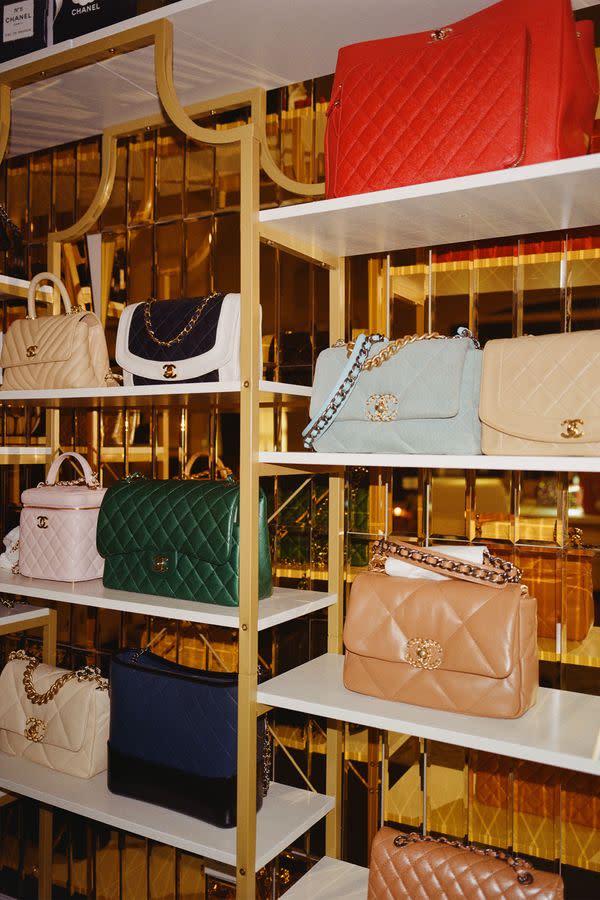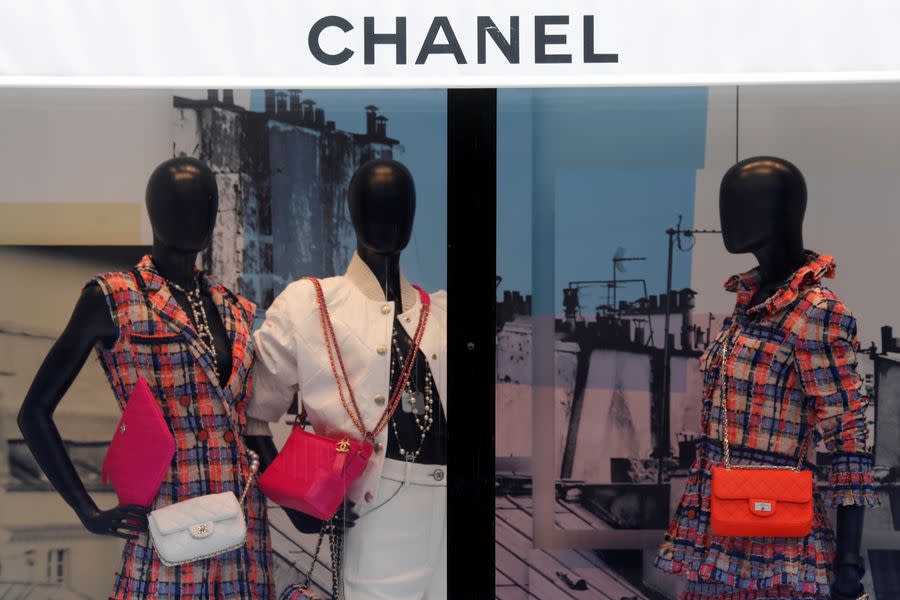You Spent $6,000 on a Secondhand Chanel Bag. Now Find Out if It Is Real.
SAN ANTONIO, Texas—The handbag had all the hallmarks of a classic Chanel: sumptuous quilted leather, sparkling gold hardware, delicate stitching. Just a couple of things were off.
Most Read from The Wall Street Journal
Apple Turned On a Buried iPhone Setting. You Might Want It Off.
Trump Makes a New Fortune With Public Listing of Truth Social
The New Normal for Mortgage Rates Will Be Higher Than Many Hope
FAA Ramps Up Oversight of United Airlines After Recent Safety Problems
One CEO’s Radical Fix for Corporate Troubles: Purge the Bosses
“The leather is too symmetrical,” said Zekrayat Husein, studying the bag through a microscope, “and each pebble is not supposed to be the same size.” It was a good fake, she said, but worthless compared with the $11,000 that the Chanel flap bag fetches at retail.
Many secondhand luxury shoppers say Husein, a 43-year-old Palestinian mother of three and a former aesthetician who goes by the nickname Zeko, is the Coco Chanel of authentication. She has evaluated over 25,000 Chanel bags since she started her business in 2019, she said. She authenticates hundreds of bags a week.
Husein will tell you that Chanel bags sold in Japan from 1985 through 2016 have the bag’s date of purchase and boutique initials inside; that Chanel’s MSHLG (metal shiny light gold) hardware is closer to champagne than bronze, while its MPY (or metal pale yellow) has a darker tone of yellow; that Chanel classic medium flap bags in colors other than black are exclusively made in France and never in Italy; that 10218184 is the serial number counterfeiters use the most.
Chanel and Husein aren’t affiliated; she assumes the brand isn’t her biggest fan. “I make it safe for people to buy not-brand-new, and that’s not good for them,” she said of the company.
Chanel declined to comment on Husein or her business. A spokeswoman for the company said it “recommends that customers buy our products from the brand’s authorized points of sale, as training and knowledge regarding authentication of genuine Chanel-branded goods could only reside within Chanel and only Chanel skilled staff can know what genuine Chanel is.”
Most of her clients, who are buying used Chanel bags from boutiques or online resellers, will email Husein photos of their purchase, taking close-ups of stitching, hardware, and interiors. Husein charges $50 for her authenticity certificate based on photos and also does in-person inspections for $100.
The market for secondhand luxury soared to $49.3 billion worldwide last year, according to Bain & Co. Sites like the RealReal, eBay and Vestiaire Collective offer a trove of coveted bags, some vintage and others in like-new condition.
The boom in resale comes as Chanel and other luxury brands are boosting their prices. A Chanel classic medium flap bag now costs $10,200, up from about $5,800 in 2019. In 2021, Chanel began limiting the number of its “Timeless Classic” quilted bags U.S. customers could buy to two annually, a move a Chanel spokeswoman said were “appropriate measures” for highly sought-after items.
Price hikes and purchasing limits on bags haven’t kept wealthy shoppers away from Chanel. Its annual revenue rose 17% in 2022 to $17.2 billion. But the sticker shock is fueling the resale market as the best option for mid-priced customers, who can score a pre-owned Chanel bag ranging from $3,000 to $8,000.
What has followed is a cottage industry of independent authenticators who can easily tell a counterfeit from the real McCoy. But their jobs have gotten harder as the quality of fakes has reached new heights, so even high-end consignees may end up unwittingly selling knockoffs. Return fraud, where customers buy real luxury goods, then get refunds by returning fake ones, also plagues the primary market.
“There are tons of really good fakes out there, and it’s scary to think about when you are making a purchase of this size,” said Tricia Jezierny, a 48-year-old executive in North Haven, Conn. She used Husein to authenticate a $6,000 rose gold Chanel bag she bought on Facebook.
Husein sometimes works as an intermediary between a buyer and seller, verifying the authenticity of a bag before a purchase. She said she’s gone head-to-head with banks, insurance companies and resale marketplaces to help customers who were sold counterfeits get their money back.
“It’s like a little treat for me when they win the case,” she said.
Born in Jordan, Husein grew up in Saudi Arabia and said she noticed glamorous Saudi women often carrying Chanel purses. She moved to the U.S. in 2000, when she got married and started flipping bags on eBay in 2005. A Chanel collector, Husein used to share free advice for buyers and sellers in a Facebook group she moderated before offering the service professionally.
Of the average 50 bags she reviews a day, around 10 are counterfeits, she said. She feels for clients who are devastated to learn this. “These women save for years for this bag,” she said. “It’s not just a Chanel bag for her, it’s the dream.”
Inside Husein’s home office, which is decorated with Chanel coffee-table books and cheeky Chanel artwork (“home is where my Chanel is”), golden bookshelves held dozens of Chanel purses of all styles and colors. The bags all looked legit, but Husein deftly weeded out several bad fakes, good fakes, very very good fakes and a new kind of counterfeit Husein called a master fake.

“They use the exact same leather as Chanel,” she said of the brand’s high-quality lambskin materials. A spokeswoman for Chanel said the brand “is always working to improve the quality of its products, and is using the best, most expensive and rarest skins.”
Others who have turned their love of luxury into a marketable skill include Paola Tapia, 35, an Atlanta-based authenticator who checks Chanel, Louis Vuitton and Gucci goods for boutiques in the area and for shoppers online. Michelle Peeters, a 38-year-old reseller and authenticator in Brooklyn, N.Y., said she examines around 30 Chanel bags a week.
There are tools of the trade for verifying the authenticity of a handbag. Tapia authenticates with Entrupy, a piece of software that compares photos taken with a micro-lens gadget to those in a database. Laura Chavez-Sainz, senior authentication manager of Fashionphile, a luxury-resale site, said she likes to use a jeweler’s loupe, flashlight and dental tools.
Cici Mone, a 40-year-old content creator in New Jersey, said she paid $50 for Husein’s services after buying a $7,200 Chanel bag from Fashionphile. The bag was already authenticated by the luxury platform, but Mone was worried it was too light to be real.
“I just wanted another set of eyes and just to have peace of mind,” said Mone. Husein gave it her seal of approval.
Carly Mulvenna, a 29-year-old handbag seller in Chicago, uses the services of Peeters, whose business is called Designer Pawn. “When you say you are selling a bag that has Designer Pawn authenticity, or authentication from Zeko, people feel confident in buying the bag,” Mulvenna said.
Like Husein, Peeters also entered the authentication world as a reseller in 2009. Touching and seeing bags helped her become well versed in Chanel’s language. She co-moderates a Chanel Facebook group with over 130,000 members and began authenticating Chanel bags in 2020. She charges $35 for certificates.
“It’s never one isolated thing that you are looking for, but a puzzle of pieces and how they all connect,” said Peeters. “The depth of the engravings, the silhouette, the interiors, the heat stamp, the foiling technique. You need a certain eye.”

Chanel is cracking down on the secondary market, alleging that vintage dealers are engaging in counterfeit sales. In February, Chanel won a lawsuit against the website and New York boutique What Goes Around Comes Around; a jury ruled Chanel was owed $4 million in damages related to counterfeiting. “Such infringements hurt consumers and harm the Chanel goodwill and brand,” said the Chanel spokeswoman in a statement. WGACA declined to comment.
A lawsuit Chanel filed against luxury-consignment giant The RealReal in 2018 is still pending. The company also recently filed new lawsuits against resellers in Atlanta, and has also gone after sellers in New York and on the China-based site DHGate. “We take inauthenticity allegations seriously and are constantly refining our systems to ensure we are addressing customer feedback and continually improving,” a spokesperson for the RealReal said.
Chanel declined to comment on pending litigation.
Megs Mahoney Dusil, co-founder of the handbag site PurseBlog, said she’s noticed more Chanel fans gravitating to smaller, independent resellers, making services from Husein or Peeters more in demand. Shoppers feverishly swap stories on blogs and social media about counterfeits sold on big sites.
These days, Husein said she’s on high alert for bags that have been redyed or refurbished with non-Chanel hardware, which can decrease their value.
Authenticators are also on the lookout for return fraud. There are some telltale signs, like sellers listing multiples of the same bag or items with tags. When Fashionphile noticed that a seller was doing this with Gucci bags, it flagged the seller internally and rejected her sales, said Chavez-Sainz. Fashionphile also contacted the store whose receipts the seller had shared as proof of authenticity. The store said it was building a case against the seller because she was bait-and-switching the bags.
“It was like ‘CSI,’ ” Chavez-Sainz said.
Write to Chavie Lieber at Chavie.Lieber@WSJ.com
